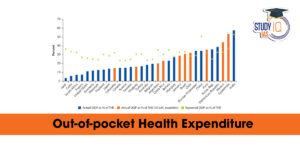Table of Contents
Context: Trade wars, tariff reviews and new bilateral deals are reshaping global commerce. For an export-oriented India, this turbulence is both a near-term issue and an opportunity to lock itself into the new supply-chain geography.
Current Situation in Global Trade War
- Resurgence of Trade Wars: Countries are imposing or reviewing tariffs, especially the U.S., on strategic imports.
- Proliferation of Bilateral Trade Agreements (BTAs): Shift from multilateralism to mini deals and FTAs, making trade rules more fragmented.
- Geopolitical Tensions: Conflicts (e.g., U.S.-China, Middle East) are disrupting supply chains and raising shipping costs.
- Supply Chain Realignment: Global firms are adopting ‘China +1’ or ‘friend-shoring’ strategies to diversify manufacturing bases.
- India’s Trade Exposure: The U.S. is India’s largest export market (~20% of merchandise exports).
- Sectors like gems & jewellery, pharma, auto parts, and textiles are highly dependent on the U.S.
Why This Can Be a Problem
- Uncertainty in Tariff Regime: Unclear U.S. trade policy disrupts planning and pricing for Indian exporters.
- Threat to MSMEs: Tariff increases could make Indian exports unviable, especially for smaller firms.
- Dumping Risk in India: Countries like China may divert excess output to India, hurting domestic industries.
- Delayed Investment & Export Orders: Businesses delay capital investment and orders due to uncertain returns.
- Muted Export Gains Despite Tax Cuts: Income tax cuts haven’t spurred consumption significantly, affecting demand.
Opportunities for India
- Supply Chain Diversification: India can emerge as a key alternative manufacturing base for global companies.
- First-Mover in U.S. BTA: Early conclusion of a trade deal with the U.S. can offer a competitive edge.
- Robust Services Sector: India’s IT and digital exports remain resilient and continue to grow.
- Expanding FTA Network: FTA with the U.K. concluded; talks with EU and Australia ongoing.
- Potential to Anchor Global FDI: India can attract companies relocating from China, Vietnam, etc.
What are the RBI’s Actions Against the Global Trade War
The Reserve Bank of India (RBI) has cut interest rates and adopted a growth-supportive stance amidst global economic turmoil.
- Monetary Policy Adjustment: RBI’s Monetary Policy Committee cut the repo rate by 25 basis points.
- Policy stance shifted from neutral to accommodative, suggesting room for more rate cuts.
- GDP Growth Revision: RBI reduced the FY26 GDP growth projection from 7% to 6.5%, anticipating trade war impacts.
- Inflation Forecast Adjustment: The CPI inflation forecast for FY26 was lowered from 2% to 4%, reflecting reduced food inflation.
- Forex Market Interventions: RBI is ready to intervene in the forex market to manage volatility.
- It holds a robust $676 billion in forex reserves, covering about 11 months of imports.
India’s Economy Amidst Global Trade War
- Growth Impact: Trade tensions have already caused a 2–0.3% potential GDP loss.
- Export Dependence: India’s exports-to-GDP ratio is relatively low:
- 21% for goods and services,
- 12% for goods.
- This makes India less exposed to U.S. tariffs than countries like Vietnam (87%) and Thailand (65%).
- Indirect Economic Effects: Possible slowdown in global demand, capital flows, and private sector investment, especially post-COVID recovery.
India’s Inflation Outlook
- Current Inflation Trends:
- CPI inflation dropped to 6% in Feb 2025, from 8.5% (Oct–Dec 2024 average).
- Food inflation decreased to 8%.
- Core inflation remained low, averaging 5% over the past year.
- Revised Forecasts: RBI revised the FY26 CPI inflation forecast down to 4% from 4.2%.
Currency and External Sector Outlook
- US Dollar Volatility: Between Oct 2024 and mid-Jan 2025, the US dollar first rose 9%, then fell 6%, creating uncertainty.
- Currency Movements: The Chinese yuan fell by 6%, and the Indian rupee weakened by 4.4% from Oct 2024 to Feb 2025.
- RBI’s Forex Support: With $676 billion in reserves, RBI can stabilise the rupee, which is expected to hover around ₹88–₹89/USD by FY-end.
Positives for India’s Economy
- Favourable Monsoon: A normal monsoon is expected, which will likely boost agricultural productivity and rural demand.
- A normal monsoon and stable global commodity prices could help control inflation.
- Tax Relief and Cooling Inflation: Lower income taxes and a sharp drop in food inflation (from 8.5% in late 2024 to 3.8% in Feb 2025) could boost consumption.
- Tariff Advantage in U.S. Market: US. Tariffs on Indian goods are relatively low (26%), compared to:
- China (145%)
- Vietnam (46%)
- Thailand (36%)
- This presents an opportunity for India to increase its U.S. export share.


 Out-of-Pocket Health Expenditure, Reason...
Out-of-Pocket Health Expenditure, Reason...
 Treasury Bills (T-bills): RBI Cuts Holdi...
Treasury Bills (T-bills): RBI Cuts Holdi...
 Fisheries Sector in India, Current Statu...
Fisheries Sector in India, Current Statu...

























